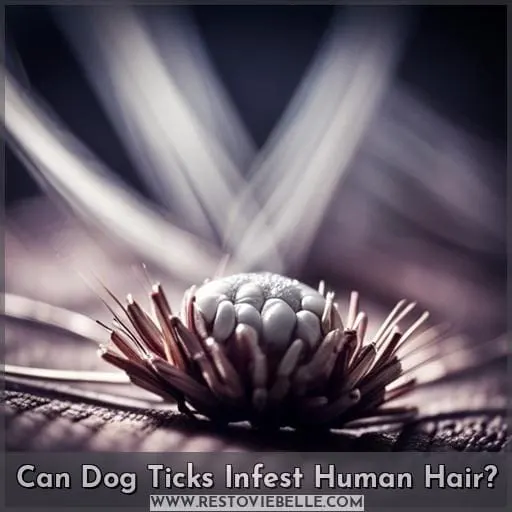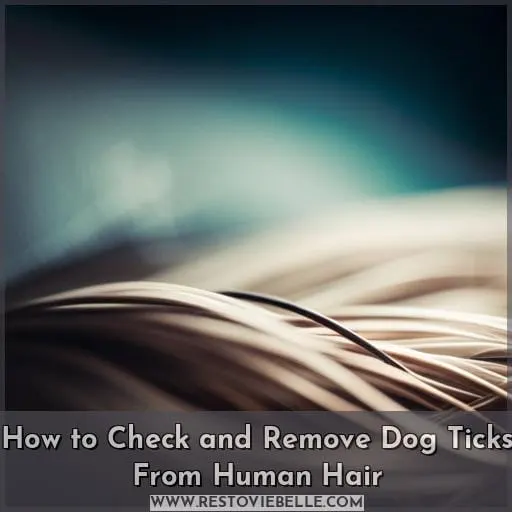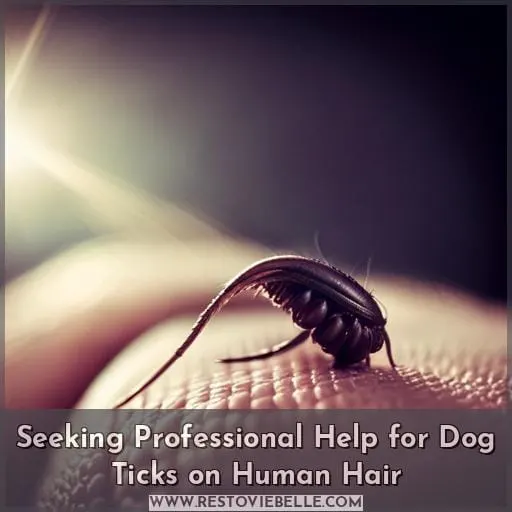This site is supported by our readers. We may earn a commission, at no cost to you, if you purchase through links.
 Imagine finding a tick crawling in your hair. It’s not the most pleasant thought, but it’s important to know if dog ticks can infest human hair.
Imagine finding a tick crawling in your hair. It’s not the most pleasant thought, but it’s important to know if dog ticks can infest human hair.
In this article, we will explore the possibility of dog ticks living on your scalp and the risks they may pose. We’ll also discuss how to check for and remove these pesky parasites from your hair.
So let’s dive into this topic and arm ourselves with knowledge about dog ticks on human hair!
Table Of Contents
- Key Takeaways
- Can Dog Ticks Live on Human Hair?
- What Are the Risks of Dog Ticks on Human Hair?
- How to Check and Remove Dog Ticks From Human Hair
- Can Dog Ticks Lay Eggs in Human Hair?
- Can Dog Ticks Cause Hair Loss in Humans?
- Can Dog Ticks Transmit Diseases Through Human Hair?
- Seeking Professional Help for Dog Ticks on Human Hair
- Frequently Asked Questions (FAQs)
- How long can dog ticks survive on human hair?
- What home remedies can I use to kill dog ticks in my hair?
- Will dog ticks from my hair spread to my furniture and bedding?
- If I have short hair, am I less likely to get dog ticks than people with long hair?
- Can dog ticks bite other areas of my body after being in my hair?
- Conclusion
Key Takeaways
- Ability of Dog Ticks to Infest Human Hair
- Risks of Dog Ticks on Human Hair
- Transmission of Dog Ticks from Pets to Humans
- Unlikelihood of Dog Tick Eggs in Human Hair
Can Dog Ticks Live on Human Hair?
While ticks certainly can and will latch onto human hair while seeking a blood meal, survival and reproduction require a more sustained attachment to human skin.
Though not specially adapted for humans, dog ticks opportunistically bite people, transmitting diseases, and must be promptly removed from hair using fine-tipped tweezers to prevent migration to the scalp.
Regular tick checks after potential exposure and proper protective clothing can prevent dog ticks from accessing and clinging to human hair.
Dog Ticks Vs. Human Ticks
If you’re wondering whether dog ticks can live on human hair, it’s important to understand the difference between dog ticks and human ticks.
Comparative anatomy plays a role in their ability to infest hair, while tick-borne risks and disease transmission make professional intervention crucial for tick removal.
Can Dog Ticks Infest Human Hair?
Dog ticks can infest human hair, increasing the risk of transmitting tick-borne diseases.
It’s important to practice proper hair care and regularly check for tick infestation, especially after outdoor activities.
Identifying ticks and removing them promptly are crucial steps in preventing tick-related health issues.
Transmission of Dog Ticks to Humans
By entering homes on pets, you’re at risk of dog ticks transferring to human hair.
Cross-species infestations occur through close human-pet contact.
Checking both yourself and pets after activities can prevent transmission.
Promptly removing any ticks with tweezers helps reduce disease risks.
Removal and Prevention of Dog Ticks on Human Hair
You’ll need to carefully check your hair and use proper tick removal techniques to get rid of any attached ticks.
| Tick Removal Techniques | Tick Prevention Tips |
|---|---|
| – Use fine-tipped tweezers for gentle, steady removal |
- Grasp the tick as close to the skin’s surface as possible
- Pull upward with a steady motion without twisting or jerking
- Wear protective clothing such as long sleeves, pants tucked into socks, and hats when in potential tick habitats
- Apply insect repellent containing DEET on exposed skin
By following these practices, you can effectively remove dog ticks from your hair and prevent future infestations. Stay vigilant in conducting regular tick checks after outdoor activities for early detection and prompt action against these pesky parasites.
What Are the Risks of Dog Ticks on Human Hair?
When it comes to dog ticks on human hair, there are several risks to consider.
Firstly, tick-borne diseases can be transmitted through the bite of an infected tick, leading to illnesses such as Lyme disease or Rocky Mountain spotted fever.
Secondly, some individuals may experience allergic reactions to tick saliva when bitten on the scalp or other areas of the head where hair is present.
Lastly, infestation by dog ticks can cause itchiness and irritation in the scalp area due to their feeding activity and movement in the hair follicles.
Tick-Borne Diseases
When bitten by dog ticks on your hair, there’s a risk of contracting tick-borne diseases like Lyme disease.
Carefully check your hair and scalp for any attached ticks after outdoor exposure.
Promptly remove any found ticks with tweezers to reduce disease transmission risk.
Schedule a doctor’s appointment if any rashes or flu-like symptoms develop post-tick bite, as these may indicate tick-borne illness.
Employ preventative measures like repellants and protective clothing to minimize future tick exposure.
Allergic Reactions
You’re at risk for allergic reactions from dog ticks in your hair.
These can cause:
- Red, itchy welts
- Swelling around the bite area
Tick allergies occur when the immune system overreacts to:
- Tick saliva
- Proteins transmitted during a bite.
The severity of allergic reactions can vary, but they often result in:
- Discomfort
- Itching that may persist after the tick is removed.
It’s important to seek medical attention if you experience any signs of an allergic reaction to prevent further complications.
Itchiness and Irritation
If dog ticks infest your human hair, you may experience itchiness and irritation due to their bites.
- Tick saliva provokes histamine release, inducing redness and swelling
- Repeated tick bites can trigger delayed hypersensitivity, causing severe itching
- Tick mouthparts moving in skin create pruritic irritation
Ticks inject anesthetics so bites aren’t initially felt, but later bite sites often become intensely itchy as histamines flood localized skin. Some develop tick-bite hypersensitivity, experiencing hives, nerve pain, or debilitating full-body itching from just one bite.
How to Check and Remove Dog Ticks From Human Hair
Carefully inspect your hair and scalp for any signs of tick attachment.
Use fine-tipped tweezers to grasp ticks as close to your skin as possible, pulling steadily upwards to remove the entire tick without twisting.
You should also employ prevention techniques like:
- Frequent tick checks
- Repellents containing DEET or permethrin
- Protective clothing that covers exposed skin
Conducting a Tick Check
To check and remove dog ticks from your hair, start by conducting a thorough tick check.
- Carefully examine your entire body, especially the hair, scalp, and any areas where ticks could hide.
- Look for small, dark crawling insects or embedded parasites.
- Promptly remove any found using tweezers or seek medical care if tick-borne illness is suspected.
- Prevent future infestations through control measures.
Proper Tick Removal Techniques
When removing an attached tick from your hair, use fine-tipped tweezers to grasp it as close to the skin as possible, pulling straight up slowly and steadily without twisting. This technique ensures that you remove the entire tick, including its mouthparts.
Avoid using pliers or other tools that may crush the tick or cause injury.
Remember not to burn or suffocate the tick with substances like nail polish or petroleum jelly.
Proper removal techniques are crucial in preventing further complications and should be performed promptly by a veterinarian if necessary.
Tick Prevention Measures
First, regularly inspect your hair and scalp for any signs of dog ticks.
To prevent tick infestations, use tick repellents containing essential oils when spending time in areas where ticks may be present.
Keep your yard well-maintained to minimize tick habitats.
If you find a tick on your hair or scalp, carefully remove it with tweezers and clean the area with a soap bath to reduce the risk of infection from tick bites.
Can Dog Ticks Lay Eggs in Human Hair?
It is important to understand the life cycle of dog ticks in order to determine whether they can lay eggs in human hair.
Dog ticks go through four stages: egg, larva, nymph, and adult.
While female dog ticks do lay thousands of eggs at a time, they typically prefer to lay their eggs in protected outdoor environments such as leaf litter or soil.
Therefore, it’s unlikely for dog tick eggs to be laid directly on human hair.
The Life Cycle of Dog Ticks
As we continue exploring the topic of dog ticks infesting human hair, it’s important to understand the life cycle of these pests.
- Three Stages: Dog ticks go through three stages in their life cycle – larvae, nymphs, and adults.
- Leg Count: Larvae have six legs while nymphs and adults have eight legs.
- Size and Color: The size of dog ticks ranges from 5mm to 15mm depending on their stage, with a brown coloration featuring whitish to gray markings.
- Egg-Laying Sites: While adult female dog ticks lay eggs in various locations like soil or leaf litter near where they feed or rest after engorging on blood meals from hosts such as dogs or other animals, laying eggs in human hair is unlikely.
Understanding the life cycle helps us better comprehend how these parasites can infest both humans and animals alike but reassures that egg-laying within human hair isn’t a common occurrence for dog tick species.
Preferred Breeding and Egg-Laying Sites
Visiting areas where ticks breed before realizing they could be laying eggs in your hair, you’re now worried about what to do.
Dog ticks have preferred breeding habitats such as grassy areas with low vegetation and outdoor environments.
They lay their eggs in cracks and crevices near the ground, not typically in human hair.
Understanding their reproductive behavior can help prevent infestation and ensure your safety.
Unlikely Scenario of Dog Tick Eggs in Human Hair
You won’t find dog tick eggs in your human hair.
Dog ticks typically lay their eggs in uncommon habitats such as the environment where they live or on the hosts themselves, like dogs.
They’ve ecological limitations and are unlikely to infest unexpected hosts, including human hair.
Rare infestations may occur but aren’t a common occurrence.
Can Dog Ticks Cause Hair Loss in Humans?
You may experience hair loss after a dog tick bite. Certain tick-borne diseases like Lyme disease can trigger alopecia areata, an autoimmune disorder causing patchy hair loss.
Checking for ticks after potential exposure and promptly seeking medical care if bitten are crucial to reduce disease transmission risk and associated hair loss.
Tick-Borne Hair Loss Conditions
If you’re experiencing hair loss and have been bitten by dog ticks, it’s important to consider the possibility of tick-borne hair loss conditions.
Tick behavior can affect the health of your hair follicles, leading to immune responses and tick-induced reactions.
Parasite infestation from dog ticks can contribute to various diseases such as Rocky Mountain spotted fever, southern tick-associated rash illness, relapsing fever, tapeworm risks, and even heartland virus.
Tick-Induced Alopecia
Haven’t dealt with those blighters yet? Tick bites can bring on alopecia areata, abruptly causing small bald patches on your scalp or other hair-covered skin. Certain tick species can trigger this inflammatory hair loss condition. Prompt tick removal minimizes disease risks, though hair regrowth may be unpredictable depending on factors like genetics, age, and environment.
Other Causes of Hair Loss
Frequently, hair loss results from causes other than dog ticks, like genetic factors or underlying health conditions. However, prompt tick prevention and removal minimizes disease transmission risks, including tick-borne illnesses like Lyme disease and Rocky Mountain spotted fever, which may sometimes induce hair loss if left untreated.
Regular tick checks and control measures help reduce infestation and disease transmission risks.
Can Dog Ticks Transmit Diseases Through Human Hair?
When feeding on hosts, dog ticks can transmit dangerous diseases like Rocky Mountain spotted fever.
Though ticks don’t typically infest human hair, pathogens can transfer when handling ticks caught in hair.
To prevent tick-borne illnesses, promptly remove any ticks found on oneself and use repellents when in tick habitats.
Tick-Borne Diseases Transmitted by Dog Ticks
Tick-borne diseases can be transmitted by dog ticks, including when they infest human hair. These diseases pose a risk to human health and require proper prevention measures.
Tick removal techniques should be followed to minimize the chances of disease transmission through the skin.
Understanding tick habitats and practicing good hair care can also contribute to disease prevention.
Transmission Routes and Risks
If you have found dog ticks in your hair, it’s important to understand the transmission routes and risks associated with these parasites.
- Tick-borne diseases like Lyme disease and Rocky Mountain spotted fever can be transmitted when ticks attach and feed.
- Ticks must typically be attached for 36-48 hours before disease transmission occurs.
- Checking yourself thoroughly and removing any attached ticks promptly is crucial for reducing disease risks.
Precautions for Tick-Borne Disease Prevention
To prevent tick-borne diseases from being transmitted through human hair, it’s important for you to take precautionary measures like:
- Using repellent
- Wearing protective clothing
- Checking for ticks after potential exposure
- Avoiding known tick habitats
- Prompt tick removal with tweezers
- Seeking medical care for concerning bite reactions or possible tick-borne illness symptoms
Seeking Professional Help for Dog Ticks on Human Hair
If you find a tick attached to your scalp or embedded in your hair, promptly consult a healthcare provider to assess your risk of contracting a tick-borne illness.
They can advise on appropriate testing, treatment options if disease transmission occurred, and the importance of future tick control measures for yourself and pets to prevent repeat exposures.
Don’t attempt tick removal from hair on your own as improper techniques can leave mouthparts embedded or provoke regurgitation of infectious fluids.
When to Consult a Healthcare Provider
You’ll wanna see your doctor after finding a tick if signs of illness show up or if the bite site looks infected.
It’s important to seek professional help when dealing with dog ticks on human hair to ensure proper identification, personal protection, and disease prevention. Healthcare providers can provide guidance on appropriate treatment options for tick-borne diseases and offer valuable advice for managing outdoor exposure to minimize infestation risks.
Treatment Options for Tick-Borne Diseases
Seeking professional help is essential for the treatment of tick-borne diseases caused by dog ticks infesting human hair.
- Antibiotics like doxycycline can treat many tick-borne bacterial infections if administered promptly.
- Anti-parasitic medications may be prescribed for protozoal diseases transmitted by ticks.
- Supportive therapies help manage symptoms while the body fights the infection.
Personal protection, environmental management, veterinary guidance, symptom recognition, and timely treatment all play crucial roles in effective tick disease management.
Importance of Tick Control Measures
If you notice dog ticks infesting your hair, it’s important to seek professional help for their control and removal.
Tick identification, habitat preferences, and the risks of tick-borne illnesses underscore the need for effective tick control measures.
Proper tick removal techniques and prevention strategies can also help prevent further infestations on both pets and humans.
Environmental control plays a critical role in reducing ticks’ presence in outdoor areas where they thrive.
Frequently Asked Questions (FAQs)
How long can dog ticks survive on human hair?
Unfortunately, dog ticks can survive for several days lodged in human hair while seeking an opportunity to feed.
Carefully inspect your hair and scalp after potential tick exposure, using a fine-toothed comb.
Seek medical care promptly if any embedded ticks are found to reduce disease transmission risk.
What home remedies can I use to kill dog ticks in my hair?
Apply rubbing alcohol to ticks in hair.
Gently remove with tweezers without twisting, pulling straight out from the hair’s base.
Monitor for symptoms; seek medical care promptly if fever, rash or other signs of illness appear after a tick bite.
Prevention through repellents, protective clothing is ideal.
Will dog ticks from my hair spread to my furniture and bedding?
Dog ticks from your hair can spread to furniture and bedding, creating potential infestations. These blood-sucking parasites thrive in warm environments with access to hosts. Proper tick removal, prevention methods, and thorough cleaning are necessary for safety and freedom from these unwanted guests.
If I have short hair, am I less likely to get dog ticks than people with long hair?
Having short hair doesn’t make you less likely to get dog ticks than people with long hair.
Dog ticks can attach themselves to any part of the body, including the scalp, regardless of hair length.
Can dog ticks bite other areas of my body after being in my hair?
Yes, dog ticks can bite other areas of your body after being in your hair. They’re capable of crawling and attaching themselves to any part of the body, including exposed skin. Proper tick removal is essential for preventing further bites and potential transmission of diseases.
Conclusion
As the old adage goes, an ounce of prevention is worth a pound of cure. Therefore, be vigilant in regularly checking your hair and scalp for any signs of tick attachment.
Though rare, there remains a small risk that dog ticks can transmit diseases even from brief contact. So stay informed on disease symptoms and control measures to ensure your health and peace of mind should the unpleasant scenario of discovering a dog tick in your hair become reality.












